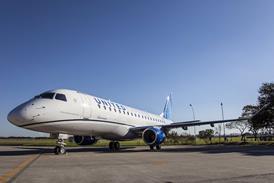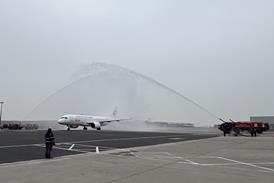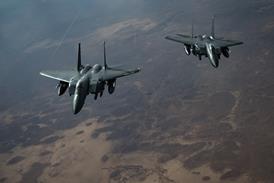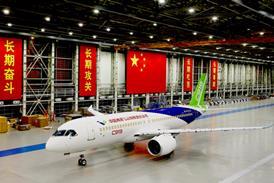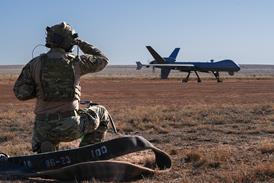A carefully choreographed and staged ritual begins every time a customer parks in front of the HondaJet delivery centre to accept handover of a new aircraft.
It starts with a personal greeting by Honda Aircraft chief executive Michimasa Fujino, who also happens to be the designer of the HondaJet and master of its several innovations.
The customer then steps into the delivery hangar itself. It is common for such a facility to be a manufacturer's most well-appointed hangar, but Honda Aircraft takes that idea to a new level. Standing before the customer is their completed aircraft, theatrically displayed on a platform that rotates under a surgically bright lighting display. The HondaJet in the centre of the room is ringed by three walls, each covered in white panels crafted to accentuate the aircraft's proportions from the perspective of the viewer. Finally, the fourth wall would normally be the hangar door, but it is covered up by a 20m (66ft)-tall, white cloth curtain.
This experience was presented by Fujino during a recent, exclusive tour of the facility. If the guest of the tour had been a paying customer instead of a journalist, the delivery ceremony would be attended by a crowd of HondaJet employees, showering the customer in a chorus of applause and cheers.
It is a ceremony as unique in the industry as Fujino himself. First assigned by Honda's research and development branch to experiment with aircraft designs in 1986, he sketched the distinctive shape of what became the HondaJet configuration in 1997. A prototype flew for the first time in 2003, and certification finally came 12 years later. Few chief executives in any industry have had such a long and detailed association with a single project as Fujino. He is credited with inventing several of the HondaJet's most important innovations, including a natural laminar flow profile and over-the-wing engine mounting.
AESTHETIC SENSE
During the tour, however, it's clear he takes as much pride in the aesthetic features of the HondaJet as he does in its aerodynamic qualities. Fujino famously devoted six months to shaping the control columns in the HondaJet cockpit. He also designed the ceiling lights in the delivery hangar, he says.
In the years between his 1997 sketch and the 2015 certification, Fujino also personally directed the automotive-style design of the HondaJet's exterior and interior. Again, his approach broke with tradition in the business jet industry. For the exterior, he allowed customers to choose between several bold colours, but, like a car manufacturer, standardised the livery design across the fleet.
A Fujino-guided tour of the interior reveals similar automotive touches. Although he earned an aeronautical engineering degree, Fujino began his career at Honda Motors in the automotive division. The influence of Honda’s vast automotive operations runs deep in the HondaJet. The lavatory of the HondaJet cabin, for example, features a small skylight. Fujino acknowledges that such a design feature is anathema to structural engineers, but he insists it is central to his own – and Honda's – consumer-oriented design philosophy.

HondaJet is infused with Michimasa Fujino's automotive-inspired design philosophy
BillyPix
As he views the aircraft manufacturing business, he finds too much emphasis on the preferences of engineers over customers. "I really want to change" the aircraft field, he says, adding, "the automobile thought process is not just about [saving] weight".
Of course, weight savings are still important in aircraft design. That is why the HondaJet is designed with unique aerodynamic features, such as over-wing engine mounts. It also boasts a natural laminar flow wing and nose section. Those features combined improve fuel efficiency by at least 10%, Fujino says. And the decisions complicated the development and certification process, which was further stymied by the challenges with validating the aircraft's GE Honda Aero Engines-made turbofans. At the same time, that additional fuel efficiency gave Fujino more options for a customer-friendly interior design, including the skylights.
In Fujino's view, HondaJet’s unconventional configuration normally would be impossible in the aviation industry's product development culture. He criticises the committee-based approach to decision-making in aircraft design, with the need to balance the demands of various engineering teams – wings, fuselage, systems, or empennage – prioritised over the customer's interest. In Honda Aircraft, much of the fundamental design and decision-making falls to Fujino, who is also chief executive of the company.
So far, that approach seems to be working in the HondaJet's segment of the market for light or entry-level jets. Customers are now flying 84 HondaJets delivered from the factory, making the aircraft the top seller in its category last year.
HondaJet’s early success has inspired imitators. In the last few years, other business jet manufacturers have spoken of a new appreciation for automotive-style design features. Some have even incorporated certain features, such as skylights and standardised livery schemes, that Fujino claims as his intellectual property. After noting that he owns a patent for integrating a skylight in a business jet cabin, he demurs from answering a question about whether he would seek legal recourse.
GAINING TRACTION
For Honda Aircraft, there are other priorities at the moment. The HondaJet has gained momentum after 18 months of customer deliveries. The Greensboro, North Carolina factory is building new aircraft at a rate of four per month. During a tour of the final assembly line, nine aircraft were in various stages of final assembly. The assembly hall has room for two assembly lines, but only one is currently occupied.
To expand production, HondaJet must find a way to increase sales. Signs suggest the market is heading in the right direction. The inventory of used business jets of all sizes dropped below 10% for the first time since before the 2008 recession in the first quarter, according to figures released by JetSmart on 9 May. That usually indicates higher demand for new jets, giving manufacturers additional pricing power with fewer viable options for used jets on the market.
However, Fujino again takes a different view from the business jet industry's convention.
"My viewpoint of the business jet industry is a little different. Many people treat the business jet market with macroeconomics, like GDP," he says. "But the business jet industry is not like automobiles or houses. The population of the products is much less than the automobile or housing market.
"Of course there is some correlation between GDP and sales, but if you have a big hit – if HondaJet sold 50, the market will increase 5% or 6%. It's very different [in the automotive market]. Even if [Honda] has one big hit in automobiles, it doesn’t affect the percentage. Of course, I’m looking at the macroeconomic statistics. But what I'm looking at more is how the business jet market can be expanded instead of looking at GDP or the gross economy."
For a clue into Honda Aircraft's strategy for broadening the base of business jet users, Michimasa points to a recent partnership formed between All Nippon Airways and HondaJet in Japan.
"We provide a feeder service using HondaJets. Not many people know business jets or even how to charter business jets in Japan, because there is no culture to use business jets. Only a few people use them. But if we have a partnership with ANA, probably many people start to notice how business jet can be used," he says.
Such an agreement potentially offers a new route to market for business jet manufacturers. In the entry-level jet category, a vast experiment in jet-powered air taxis fell apart because certain operators, such as Florida-based DayJet, tried to grow too quickly.
"I understand the DayJet concept. It was very attractive in the beginning, but a little bit too far from reality. You have to take really small steps. My first step is to increase the fleet of HondaJets to a certain level," Fujino says.
"If we could estimate how many hours are available from those aircraft, probably, I think we can arrange a time-sharing time type business because airplanes are available," he continues. "What we are doing now is we try to achieve that fleet size. That's why we do not only track just the people who own business jets, but the people who have never used business jets before. We're not only tracking the aircraft buyer but also the aircraft user.
"That’s why I brought up the example of ANA. Many airline passengers never think of using business jets, but if demand is expanded maybe even… from 1% to 10%? And, if demand is there, then charter operators have to increase [their] fleet,” he says.
Having outlined his long-term strategy, Fujino is asked to share his short-term plans. The business jet market typically rolls out a major refresh within about five to seven years after each new model is introduced. The goal is to stimulate new demand with product improvements after the manufacturer has had a chance to maximise the return on the initial investment in the clean-sheet aircraft.
Again, Honda Aircraft is considering taking a different approach, with its reference point being the consumer-oriented automotive culture of its parent.
"I work from the automotive industry. So, the [market] cycle is not as long as aviation people think. Hondajet now has good momentum. But now I want more momentum," says Fujino, but he declines to elaborate.
Such comments also reveal Honda Aircraft's unique position in the aviation industry. Aviation start-ups normally enter the market on a shoestring budget, but the HondaJet is backed with the balance sheet of a parent company that earns $140 billion in sales each year. It has waited a long time for its investment in the aviation market to pay off, but that has been the strategy all along, Fujino says.
"The reason why Honda entered a business like aviation is we see ourselves as a mobility company," he says. "We really want to be a leading mobility company. The definition of mobility includes aviation. We are looking at this business segment as not just one year or two, it's very long-term."
In the long term, Honda hopes to reap a synergistic effect from pooling ideas and lessons from its wide array of product lines, ranging from cars to motorcycles to lawnmowers to business jets.
CROSS FERTILISATION
"We cannot use the shape of an aircraft for an automobile, but the technology can be applied to how to validate and verify the reliability of a product," he says. "So, I think it is probably a very big strength of Honda to have diverse viewpoints and diverse technology which can resonate and produce a synergy effect as an entire company."
In the latest year for which figures are available, the fiscal year ending 31 March 2017, Honda Aircraft and GE Honda Aero Engines reported a combined operating loss of ¥43.8 billion ($401 million), an inauspicious beginning for the first full fiscal year of production. Despite the early losses, Honda remains committed to the HondaJet programme, Fujino says.
"We have a very tight and stringent target, so each year we are striving to meet that business target. The business target of course starts from a profit or loss, so a financial target," Fujino says. "Many business goals are set and we have to strive to meet those business goals. So far, we are kind of meeting those expectations so we have strong support from Honda Motors. And that's why we keep investing for the future as well."
Get all the coverage direct from EBACE here
Source: FlightGlobal.com

